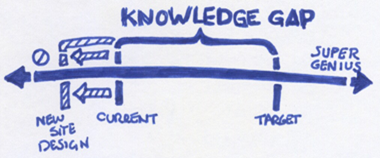Knowledge Gap Hypothesis:
Introduction:
This theory is concerned mainly with “information” and “knowledge” and emphasizes that knowledge is not distributed equally throughout society.
There are haves and have-nots with regard to information just as material wealth Information is very important in our society because any developed country depends on well-informed citizens.
It appears certain that information will be even more important in the future as we move into an increasingly technological age.
Many contemporary issues will require information and an informed public for the solutions for such issues.
Role of mass communication:
* One of the great promises of mass communication is that it provides people with information they need.
* It has the potential of reaching people who have not been reached by other means (poor and undeveloped people).
One example of an effort to use mass communication to provide information to the disadvantaged is the “educational TV program” Sesame Street (which combined information with entertainment for preschool Children.).
Other mass communication efforts that have the advantage of getting information to people usually not reached
is the televised presidential debates that might take the presidential election campaigns to people who would not normally be exposed to the campaign.
The attempts to increase people’s quantities of information from mass media might have some unexpected or undesirable effects.
This undesirable possibility is that mass communication might actually have the effect of increasing the gap in knowledge between members of different social classes. This possibility is called: “ Knowledge gap Hypothesis”.
The authors of Knowledge Gap Hypothesis:
- § The Knowledge Gap Hypothesis was first proposed in 1970 by Tichenor, Donohue and OLien. Mostly, it is known as Tichenor et al or Tichenor and his colleagues’ hypothesis.
Tichenor et al . Stated the KG Hypothesis as follow:
“As the infusion of mass media information into a social system increases, segments of the population with higher socio-economic status tend to acquire this information at a faster rate than the lower status segments, so that the gap in knowledge between these two segments tend to increase rather than decrease”.
The hypothesis predicts that:
- § People of both high and low socioeconomic status will gain in knowledge because of the additional information, but that persons of higher socioeconomic status will gain more.
- § This would mean that the relative gap in knowledge between the well-to-do and less well-off would increase.
Tichenor and his colleagues suggest that:
The K. G. is particularly likely to occur in such areas of general interest as public affairs and science news. It is less likely to occur in more specific areas that are related to people’s particular interests-areas like sports or garden care.
Operational forms of the Hypothesis:
Techinor et al 1970 say that KG hypothesis might be stated in two ways:
- §Overtime, acquisition of knowledge of a heavily publicized topic will proceed at a faster rate among better- educated persons than among those with less education.
- §At a given time, there should be a higher correlation between acquisition of knowledge and education for topics highly publicized in the media than for toics less highly publicized.
Possible reasons for Knowledge Gap:
- § There is a difference in communication skills between those high and low in socio-economic status. (mainly education which prepares one in reading, comprehension and remembering skills)
- § There is a difference in the amount of stored information or previously acquired background knowledge.
- § People of higher socioeconomic status might have more relevant social contact. (they might enter discussions of certain topics with others).
- § The mechanisms of selective exposure, acceptance and retention might be operating. (Persons with low SES might not find or be interested in topics such as public affairs or science news).
- § The nature of the mass media system itself is that it is geared toward persons of higher SES.
Factors that might reduce or wide the Gap:
- § Widening knowledge gaps are more likely to occur in communities with numerous sources of information (Pluralistic communities) than with informal but communication channels (Homogeneous communities).
- § When an issue has immediate and strong local impact, the knowledge gap is likely to decline.
- §A well-known celebrity involved in the dissemination of information could help achieve wider visibility for and acceptance of the information.
- §When an issue arouses basic social concerns, the knowledge gap is likely to be reduced or eliminated.
- §Researchers found that television may have a special power to close knowledge gaps or, if not to close them, at least to keep them from widening.
The KG and the New Technology:
- §It is not clear what are the effects of the new technologies will be on level of information held by the public.
Many of the new technologies are expensive.
Because of the cost, these technologies may be more available to the well-to-do than to less –well-off.
- § For this and other reasons, the effect of the technological revolution in communication could be a further widening of the KG. So, availability of the new technology may affect the KG.
- § If the access to these information services is not universally available throughout the society, then those already “information-rich” may reap the benefits while the “information-poor” get relatively poorer.
A widening of this “information gap” may lead to increase tension.
Criticism of the Knowledge Gap Hypothesis:
- § Dervin (1980) criticized the KG for being based on the traditional source-sending-messages –to-receiver paradigm of communication. She recommended that communication campaigns and researchers be more user-based and user-constructed information.
Evatt (1998) argued that researchers should be sure that the information they are testing is useful and relevant for the audience being tested.
(factual versus conceptual knowledge)
